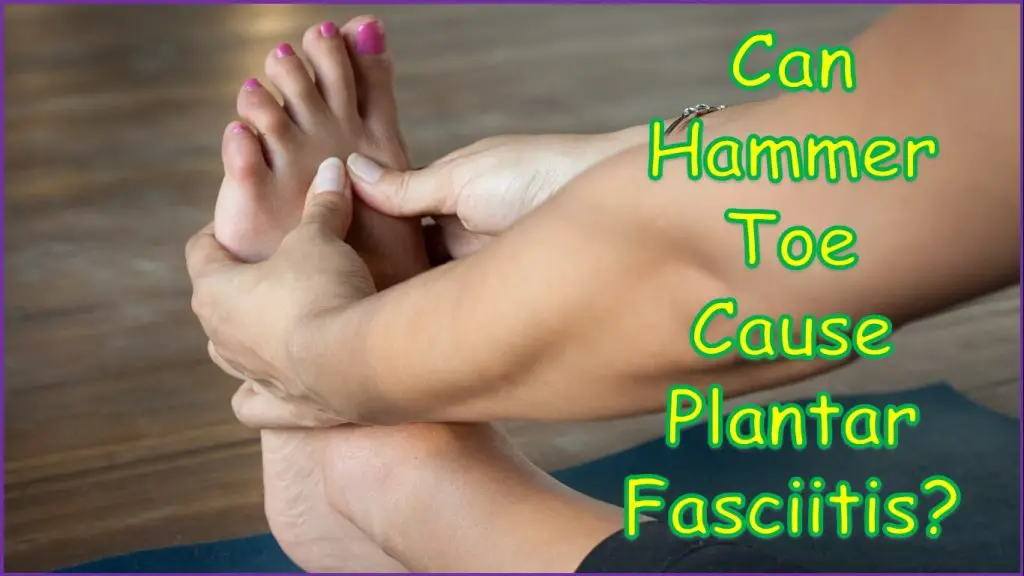Can Hammer Toe Cause Plantar Fasciitis?
While hammer toe and plantar fasciitis are separate foot conditions, they can sometimes coexist, potentially exacerbating foot discomfort.
Hammer toe, a common foot deformity, affects the smaller toes’ middle joint, causing them to bend downward instead of pointing forward. This abnormal positioning leads to pain, stiffness, and difficulty wearing certain footwear. While muscle imbalances often cause hammer toe, it can also result from genetics, arthritis, or ill-fitting shoes.
Let’s delve into the basics of plantar fasciitis. This condition involves inflammation of the plantar fascia, a thick band of tissue connecting the heel bone to the toes on the bottom of the foot. The plantar fascia supports the foot’s arch and absorbs shock during walking or running. When this tissue becomes irritated or damaged, it triggers intense heel pain, especially during the first steps in the morning or after prolonged rest.

Interestingly, hammer toe and plantar fasciitis, while distinct, can occasionally coexist or influence each other’s development. Here’s how they potentially connect:
Altered Foot Mechanics:
Hammer toe can disrupt foot mechanics, causing abnormal pressure distribution while walking or running. This alteration can place excessive stress on the plantar fascia, potentially leading to plantar fasciitis.
Overcompensation:
Individuals with hammer toe may unintentionally modify their gait or walking pattern to minimize discomfort. Unfortunately, this compensatory mechanism places additional strain on the plantar fascia, increasing the risk of developing plantar fasciitis.
Shared Risk Factors: Hammer toe and plantar fasciitis share common risk factors, including wearing tight shoes, engaging in high-impact activities, having flat feet, or being overweight. These factors heighten the likelihood of both conditions occurring simultaneously or one causing the other.
Now, let’s explore some general management strategies for hammer toe and plantar fasciitis to alleviate symptoms:
For Hammer Toe:
- Opt for comfortable, properly fitting shoes with a wide toe box to reduce toe pressure.
- Consider using orthotic devices or shoe inserts to provide support and cushioning.
- Engage in toe exercises and stretches to enhance flexibility and strengthen the muscles.
- Apply ice packs to reduce pain and inflammation.
For Plantar Fasciitis:
- Rest and avoid activities that worsen the pain.
- Perform stretching exercises for the calf muscles and plantar fascia.
- Utilize orthotic inserts or arch supports for additional foot support.
- Apply ice packs and use over-the-counter pain relievers to manage discomfort and inflammation.
While these self-care measures can offer temporary relief, it is crucial to consult a healthcare professional for accurate diagnosis and appropriate treatment. They may recommend additional interventions, such as physical therapy, custom orthotics, or, in severe cases, surgical options.
In conclusion, although hammer toe and plantar fasciitis are distinct foot conditions, they can have an interconnected relationship. The altered mechanics and shared risk factors associated with hammer toe can potentially contribute to the development or exacerbation of plantar fasciitis.
If you experience symptoms of either condition, it is vital to consult with a healthcare professional for proper diagnosis and personalized treatment. Remember, early intervention and appropriate management are key to relieving pain and restoring foot health.
Share this article with your loved ones, friends, and colleagues who may be experiencing hammer toe or plantar fasciitis. Help them understand the potential link between these two conditions and provide them with valuable insights.
See Also:
- Best Insoles for Plantar Fasciitis Work Boots
- Best Work Boots for Plantar Fasciitis
- Are Ryka Shoes Good for Plantar Fasciitis?
- Best Shoe Inserts for Bunions and Plantar Fasciitis
- Comfortable Shoes To Wear After Foot Surgery
- Are Barefoot Shoes Good for Plantar Fasciitis?
- Why Does My Heel Hurt When I Walk Without Shoes?
- Does Soaking Feet in Warm Water Help Plantar Fasciitis?
- Are Vionic Shoes Good for Plantar Fasciitis?
- What Are the Best Tennis Shoes for Plantar Fasciitis
- Can Achilles Tendonitis Cause Plantar Fasciitis?
- Are Dansko Shoes Good for Plantar Fasciitis?
- Is Ice Good for Plantar Fasciitis?
- Best Ice Pack for Plantar Fasciitis
- Best Brace for Plantar Fasciitis
- Does Epsom Salt Help Plantar Fasciitis?
- How to Exercise with Plantar Fasciitis?

